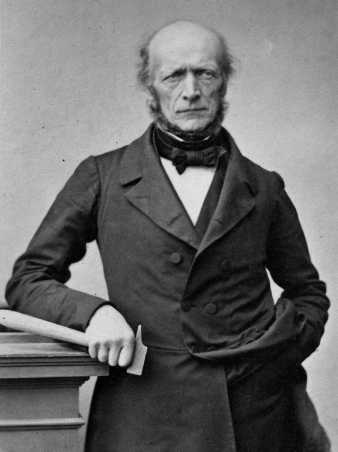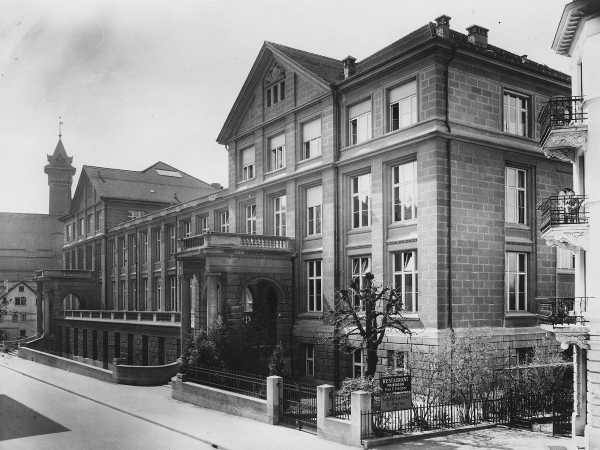History of the Department of Earth and Planetary Sciences
Initiated by Hans R. Thierstein, Emeritus Professor at the former Department of Earth Sciences
From Alpine geology to global processes and planetary systems
Today's Department of Earth and Planetary Sciences (D-EAPS) at ETH Zurich can be traced back to two professorships that were created as dual professorships with the University of Zurich at the time of its foundation: The Professorship of Geology, to which Arnold Escher von der Linth was appointed in 1855, and the Professorship of Mineralogy, occupied from 1856 by Adolf Kenngott. From the beginning until the recent past, teaching and research focussed on the geology of the Alps (e.g. Albert Heim, Professor 1873–1911). From around 1960, research and teaching activities were increasingly extended to global topics, for example with the appointment of Augusto Gansser (Professor 1958–1977). As a researcher, Gansser travelled to Greenland and took part in the first Swiss Himalayan expedition in 1936. Colombia and Trinidad were further work and research stations on his way.
From around 1960, the earth sciences in Zurich underwent a diversification of disciplines, which was made possible by the creation of numerous new professorships, e.g. geophysics, construction geology, isotope geology, micropalaeontology, structural geology, etc. Towards the end of the decade, the first lunar samples were analysed in the department, marking the beginning of research into extraterrestrial planetary systems.
This expansion and differentiation was supported by the introduction of new geophysical measurement methods, e.g. in seismology and rock magnetics, as well as new analytical equipment (e.g. electron microscopes, mass spectrometers or rock presses). The availability of electronic computers contributed to the rapid quantitative orientation of numerous, previously predominantly qualitative disciplines, such as structural and engineering geology, stratigraphy, sedimentology and micropalaeontology.
Around the middle of the last century, strong institutes with several professorships each emerged from the formerly few chairs, which today have grown together again as an interdisciplinary department.
Institutional development
Founded in 1979 as the Department of Earth Sciences (D-ERDW), the aim was to coordinate the study and professorship planning of three historically grown institutes (Institute of Geology, Institute of Crystallography and Petrography, Institute of Geophysics) and to jointly operate the earth science exhibitions and collections, as well as certain workshops. The Geographical Institute of ETH Zurich and the Palaeontological Institute of the University of Zurich were included as associate members to promote close cooperation in teaching. The Institute of Geography at ETH Zurich was reorganised as the Institute of Atmospheric and Climate Science in 2001 and since then, affiliated to the Department of Environmental and Systems Science (D-USYS), has supervised a significant proportion of Master's students (Master in Atmospheric and Climate Science) in Earth Sciences.
The Department of Earth Sciences has developed continuously since then, and the co-operation between the participating institutes and professorships in planning, teaching, operations, and research has become increasingly close.
Important turning points in the development of the department were the introduction of the Environmental Sciences degree programme (1987) and, since the early 2000s, the increasing focus on extraterrestrial structures and the creation of dedicated professorships in this area. Today, around a third of the professorships also deal with extraterrestrial systems and processes. The Department of Earth Sciences was involved in the founding (2022) and funding of the Centre for Origin and Prevalence of Life with more than half of its professorships, making it one of the two founding members alongside the Department of Physics.
In order to reflect the development since the 1970s in its name, the department changed its name to Department of Earth and Planetary Sciences (D-EAPS) on 1 August 2024.
The Department of Earth and Planetary Sciences currently consists of 19 professorships belonging to three institutes: the Geological Institute, the Institute of Geochemistry and Petrology and the Institute of Geophysics. The department also houses workshops and laboratories, the Georesources Switzerland Group, focusTerra, and the Swiss Seismological Service (SED).
Professorships in Earth and Planetary Sciences at ETH Zurich
ETH Zurich: Leading the way since 1855
Established in 1855 as the Federal Polytechnical School, ETH Zurich has, from the outset, been a national centre for education with international appeal, attracting talent from all over the world.
The successful combination of a cosmopolitan outlook with national roots made the young educational institution one of the driving forces behind industrialisation in Switzerland: it brought the necessary expertise into the country, trained technical specialists and helped set up groundbreaking national infrastructures.
ETH Zurich was given its present name, Swiss Federal Institute of Technology (Eidgenössische Technische Hochschule), in 1911. Over the decades that followed, it entered into solid partnerships with the state and with industry and invested increasingly in both applied and fundamental research, which were gaining in importance in relation to education. The university grew steadily and in 1961 it embarked on the first stage of constructing its second site on the Hönggerberg, on the outskirts of Zurich.
In more recent times, global developments such as computer-assisted data processing and the far-reaching consequences of globalisation have placed ever-increasing demands on universities. ETH Zurich reacts to these new challenges by creating flexible organisational structures: new research units and programmes have emerged and the research itself is becoming more and more integrated and interdisciplinary. The long-standing tradition of ETH Zurich, combined with its ability constantly to adapt to new requirements, have brought great success to the university. Today, it ranks among the world’s leading universities of science and technology.



